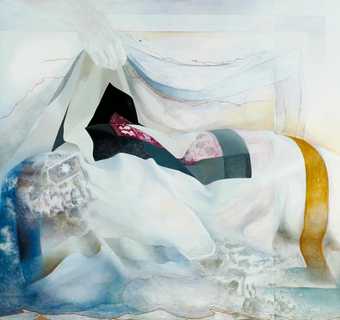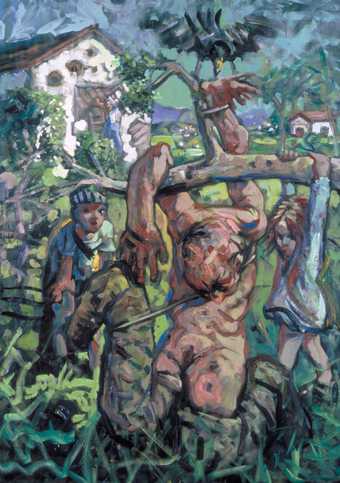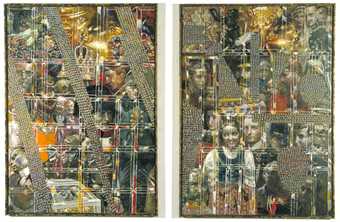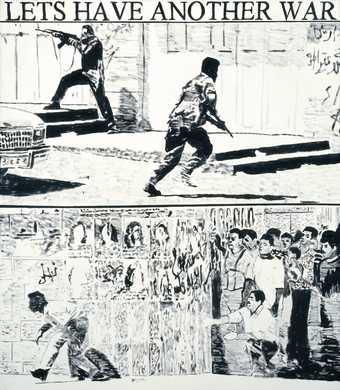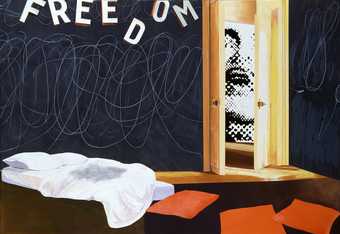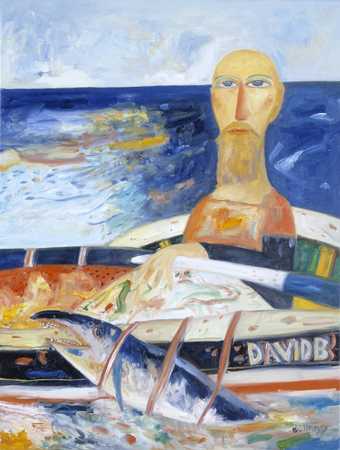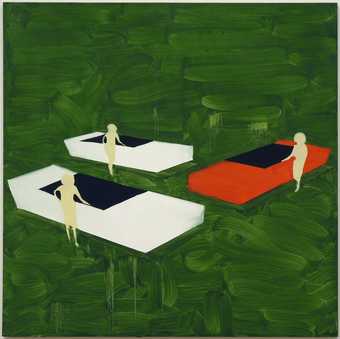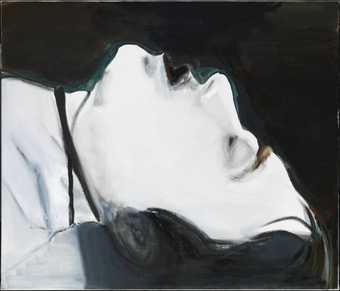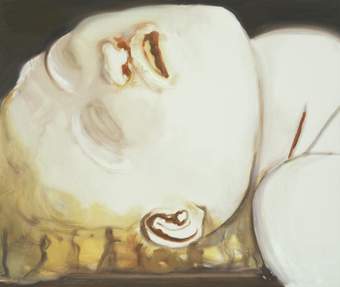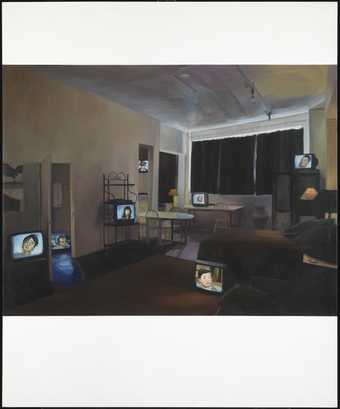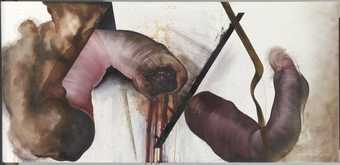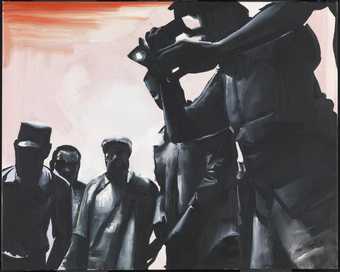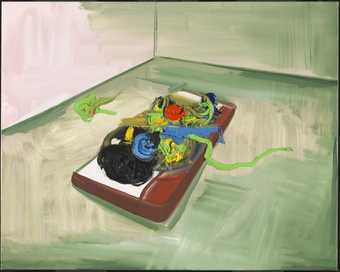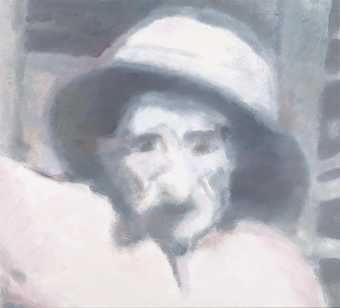
In Tate Modern
- Artist
- Wilhelm Sasnal born 1972
- Medium
- Oil paint on canvas
- Dimensions
- Support: 1600 × 2000 mm
- Collection
- Tate
- Acquisition
- Presented by the Roman Family Collection 2014
- Reference
- T14242
Summary
Gaddafi 3 depicts the body of the Libyan dictator Muammar Gaddafi, who was killed by rebels on 20 October 2011, lying on a mattress surrounded by a group of rebel fighters. Gaddafi 3 is the third in a group of three paintings based on digital images of the violent death of Gaddafi, the others being Gaddafi 1 2011 (Tate T14241) and Gaddafi 2 2011 (Tate T14240). The scale of this canvas, the largest of the three, establishes a direct physical relationship between the viewer and the fighters depicted within it, both engaged in focusing on the lifeless body. The flat application of oil paint, unusual fleshy palette and use of grey-scale with a preponderance of saturated black, are all typical of Sasnal’s practice. The dramatically foreshortened figure of Gaddafi also recalls Andrea Mantegna’s painting Lamentation of Christ c.1480 (Pinacoteca di Brera, Milan).
Rebel fighters captured Gaddafi hiding with his bodyguards in a large drainage pipe. In a series of frenzied events the dictator was wounded (either by shrapnel or gunshots) before being pulled from his hideout and killed, with conflicting accounts as to the exact means of his death. Mobile phone video footage of his last moments was quickly broadcast around the world. Within days of this taking place Sasnal decided to turn three key images of the events into paintings of different styles and scale in an attempt to rescue them for posterity and from the deluge of news imagery. Gaddafi 1, the smallest of the three, depicts the corpse of the deposed dictator lying on a mattress in an empty room. Gaddafi 2 depicts a group of rebel fighters looking at, and taking images of, Gaddafi’s body.
Born in Poland where he studied at the Kraków Academy of Fine Arts, Sasnal has produced works on paper, photographs and films in addition to painting. He typically identifies a digital image online – rather than an image printed in a newspaper or an analogue photographic print – on which to base his painting. Most paintings are completed in one sitting over the course of a single day. Experienced as a group, Gaddafi 1, Gaddafi 2 and Gaddafi 3 emphasise the editorial process of image selection involved in Sasnal’s painting practice and the wide range of aesthetic decisions involved in translating the digital image from a low-quality print-out into a ‘high-quality’ painting.
Sasnal is also represented in Tate’s collection by two earlier works, both of which were made following a visit to the United States: Untitled (a) 2004 (Tate T11915), which alludes to the mundane setting of a car showroom, and Untitled (a) 2004 (Tate T12130), which shows a sinister group of minute Ku Klux Klan-type figures in an ambiguous, non-descript landscape.
Further reading
Michele Robecchi and Craig Garrett (eds.), Wilhelm Sasnal, London 2011.
Patrizia Dander and Julienne Lorz (eds.), BILD-GEGEN-BILD/Image Counter-Image, Haus de Kunst, Munich 2012, pp.155–7.
Achim Borchardt-Hume (ed.), Wilhelm Sasnal, Whitechapel Gallery, London 2012.
Achim Borchardt-Hume
April 2013
Does this text contain inaccurate information or language that you feel we should improve or change? We would like to hear from you.
Display caption
The third and largest of Sasnal’s paintings relating to the death of Muammar Gaddafi shows both the Libyan dictator’s corpse and a group of onlookers. All but one of the figures have been rendered anonymous by the close cropping of the image so that only their bodies are visible. In this treatment of the subject, Sasnal seems to refer as much to art history as to history, evoking Andrea Mantegna’s fifteenth-century depiction of the dead Christ through the dramatic foreshortening of the corpse while also echoing the monumental scale of history painting.
Gallery label, February 2016
Does this text contain inaccurate information or language that you feel we should improve or change? We would like to hear from you.
Explore
- history(5,776)
-
- military(301)
- politics and society(2,337)
- furnishings(3,081)
-
- mattress(14)
- corpse(99)
- group(4,227)
- countries and continents(17,390)
-
- Libya(5)
- birth to death(1,472)
-
- death(685)
- public service(872)
You might like
-
Rita Donagh Counterpane
1987–8 -
Peter Howson Plum Grove
1994 -
Leon Vilaincour A Life
1984–5 -
David Reeb Let’s Have Another War No.5
1997 -
Dexter Dalwood Situationist Apartment May ‘68
2001 -
John Bellany Homage to David B
2002 -
Wilhelm Sasnal Untitled (a)
2004 -
Wilhelm Sasnal Untitled (a)
2004 -
Marlene Dumas Stern
2004 -
Marlene Dumas Lucy
2004 -
Sandra Gamarra Page 70
2006 -
Piotr Janas Slash
2010 -
Wilhelm Sasnal Gaddafi 2
2011 -
Wilhelm Sasnal Gaddafi 1
2011 -
Luc Tuymans Issei Sagawa
2014

